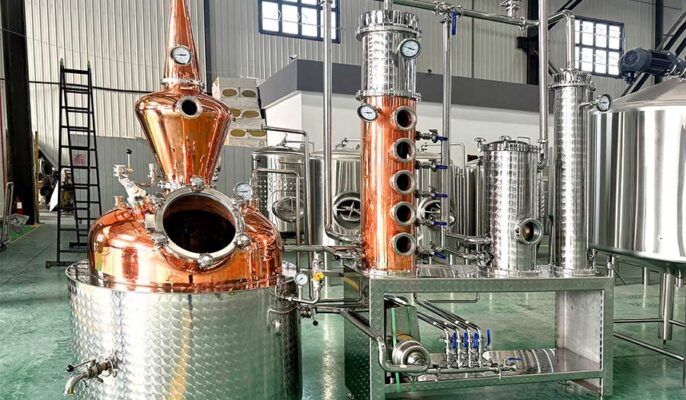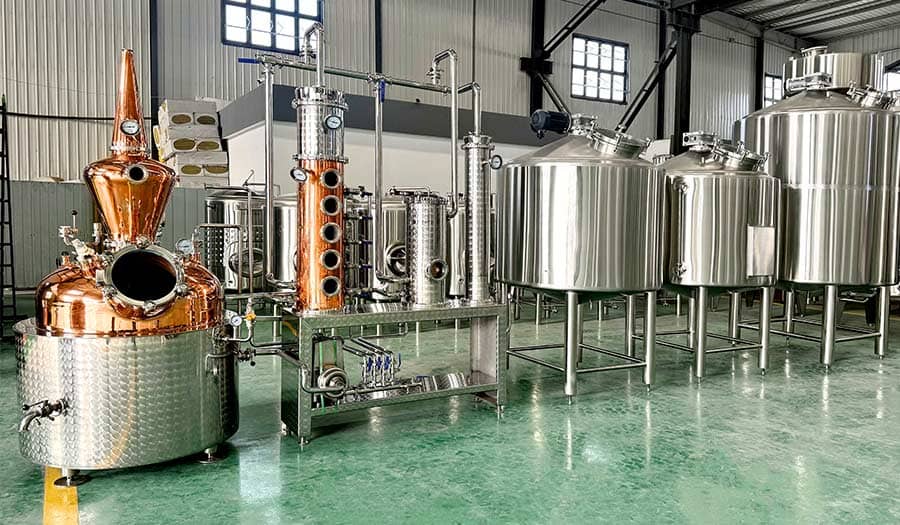蒸留装置 は、ウイスキー、ウォッカ、ラム、ジンなどの蒸留酒の製造に不可欠です。家庭用蒸留器であれ、商業用蒸留器であれ、適切な蒸留器を選ぶことは、分離工程の有効性と効率性を確保するために不可欠です。このガイドでは、蒸留の基礎を紹介し、あなたの特定のニーズに適した蒸留装置の選択について説明します。
蒸留とは何ですか?
蒸留は、液体または気体状態の異なる成分の沸点の差を利用して分離を行う。このプロセスでは、液体を蒸気に変え、再び凝縮させて容器に回収します。また、不揮発性の不純物から純粋な液体を得るためにもこの技術を使用する。また、混合物中の特定の成分の吸収を高めるためにも使用することができる。蒸留プロセスは、液体を沸点まで加熱することから始まります。これにより液体は蒸発し、蒸気を形成する。その後、気体を低温の管に通して冷却する。冷却された蒸気は凝縮し、蒸留物を形成する。
不純物を残して蒸留物を生成するので、蒸留物は元の液体の純粋な形である。集めた液体にこの工程を繰り返すことを二重蒸留と呼ぶ。

蒸留の種類
単純蒸留
単蒸留は、液体の混合物を沸点まで加熱し、生じた蒸気を直ちに凝縮させる方法である。この方法は、液体の沸点に大きな差がある混合物にのみ有効である(最低25℃の差)。蒸留液(精製液)の純度はラウールの法則によって制御される。
分別蒸留
分別蒸留は、沸点が類似した液体の混合物を分離するために一般的に使用される。分留は、いくつかの気化-凝縮工程(分留塔で行われる)を含む。このプロセスは蒸留としても知られている。混合物の分別蒸留に必要な装置を以下に示す。
- 丸底フラスコまたは蒸留フラスコ
- 熱源は火でも湯煎でもよい。
- 凝縮蒸気を回収するフラスコ
- 分画カラム
- 蒸留フラスコ内の温度を測定する温度計
- コンデンサー
- 標準的なガラス製品。
水蒸気蒸留
水蒸気蒸留は、混合物中の熱に弱い成分を分離するためによく使われる。
これは、混合物に蒸気を通し(わずかに加熱)、混合物の一部を気化させることで達成される。このプロセスは、高い熱伝達率を達成するために高温を必要としない。得られた蒸気は凝縮され、目的の蒸留物が得られる。水蒸気蒸留法は、様々な芳香のある花やハーブからエッセンシャルオイルやハーブ蒸留物を得るために使用することができる。
真空蒸留
減圧蒸留は、沸点が非常に高い液体の混合物を分離するのに理想的である。これらの化合物を沸騰させるには、高温に加熱するのは非効率的な方法である。そのため、周囲の圧力だけを下げることができる。圧力が下がることで、成分をより低い温度で沸騰させることができる。組成物の蒸気圧が周囲の圧力と等しくなると、それは蒸気に変わる。これらの蒸気は凝縮され、蒸留液として回収される。減圧蒸留は、高温で分解する化合物の高純度サンプルを得るためにも用いられる。
空気感応式減圧蒸留
空気に敏感で、空気と容易に反応する化合物については、減圧蒸留を行うことができるが、工程終了後に真空を不活性ガスで置換する必要がある。このプロセスは、しばしば空気感応減圧蒸留と呼ばれる。
短距離蒸留
短距離蒸留は、高温で不安定な少量の化合物を精製するために用いられる。このプロセスは低圧で行われ、通常、蒸留液は回収されるまでに非常に短い距離を移動する(これが「ショートラン」という用語の由来である)。この方法では、蒸留液の移動距離が短くなるため、装置の壁に沿って廃棄物が減少する。
地域蒸留
地域蒸留のプロセスでは、物質を部分的に融解させ、生じた蒸気を凝縮させて純粋な蒸留物を得る。このプロセスは、ゾーンヒーターの助けを借りて長い容器の中で行われる。
理解する 蒸留装置
蒸留装置は、蒸留のプロセスを通じて発酵ブロスからアルコールを分離するために一緒に働く様々なコンポーネントで構成されています。蒸留装置の主な種類は以下の通り:
静的
スチルは蒸留工程で使用される主要な機器である。ボイラー、塔またはポット、コンデンサーで構成される。ボイラーで液体を加熱して蒸気を発生させ、その蒸気が塔やポットを通り、コンデンサーで冷却・凝縮されて液体に戻ります。ディスティラーには、ポットスチル、カラムスチル、ハイブリッドスチルなどさまざまなデザインがあり、それぞれ異なるタイプのスピリッツや製造方法に適している。
コンデンサー
コンデンサーはスチルで発生した蒸気を冷却して液体に戻す役割を果たします。通常、冷水を循環させるコイルやパイプで構成され、蒸気を凝縮させて蒸留液として回収する。コンデンサーには、スチルのサイズや設計によって、パッシブ型(周囲の空気や水を利用する)とアクティブ型(グリコールなどの冷却剤を利用する)があります。
発酵容器
発酵容器は、糖分をアルコールその他の化合物に変換する発酵プロセスが行われる場所である。家庭用蒸留器の場合、発酵容器はシンプルなバケツや樽であるが、商業用生産者の場合、発酵容器はより大きなタンクである。発酵容器は食品用の材料で作られ、汚染を防ぎながらガスを逃がすためのエアロックを備えていなければならない。
麦汁バケツ
麦汁バケツは、水と穀物やその他の発酵原料を混ぜて麦汁を作るために使用される。麦汁を処理した後、液体(麦汁)と固形物(使用済み穀物)を分離するために、バケツには仮底やその他の濾過システムが付いていることもある。麦汁樽は、ウイスキーやバーボンなどのグレーン・スピリッツの製造に欠かせない。
選び方 蒸留装置?
- 生産規模:個人的な使用、小規模な職人的蒸留、大規模な商業生産など、ニーズに合わせて生産規模を調整できます。生産量と成長予測に見合った機器を選びましょう。
- 予算蒸留装置の購入予算を立て、初期費用と長期的な運転費用の両方を考慮する。高品質な機器は、初期投資が高くつくかもしれないが、長期にわたってより優れた性能、効率、耐久性を発揮することができる。
- 品質と素材:ステンレスや銅など、耐久性、耐腐食性、洗浄性に優れた高品質の素材を使った蒸留器を探しましょう。蒸留酒の品質や安全性を損なう可能性のある粗悪な素材の機器は避けましょう。
- 機能と仕様:容量、加熱方法、冷却システム、自動化オプション、生産工程やレシピとの互換性など、機器の機能と仕様を検討する。特定のニーズと嗜好を満たす機器を選ぶ。
- 安全性と規制要件:特に、有毒物質、引火性物質、または腐食性物質を取り扱う場合、装置の安全性能は極めて重要である。潜在的な法的問題や安全上のリスクを回避するために、機器が関連する安全および環境規制に準拠していることを確認する。
- 装置の性能と効率:分離効率と製品純度を考慮して装置を選択する。装置のエネルギー消費量とメンテナンスコストを評価し、長期的に経済的に運転できることを確認する。
- 技術サポートとサービス:良好なアフターサービスと技術サービスを提供できる信頼できるサプライヤーを選ぶ。長期的な安定稼働を確保するため、機器の保証方針とメンテナンス要件を理解する。
- エネルギーと効率蒸留酒業界では、持続可能性とエネルギー効率がますます重視されています。エネルギー効率の高い蒸留装置を選択することは、運転コストを削減するだけでなく、環境意識の高い消費者の嗜好にも合致する。




